In depth visit to the mother city of Chongqing, a must visit attraction in Chongqing, and enjoy authentic old hotpot in Chongqing!
Chongqing is a home for every person born and raised here. There are mountains, waters, stairs, tunnels, world-famous landscapes, and nationally renowned beauties here; Here are spicy hotpot, Wanzhou grilled fish, and Fuling pickled vegetables; Chatting here is called 'Dragon Gate Formation', and taxis are called 'Tuo'er Che'. There are so many interesting places in this 3D magical city that you must personally experience them in order to feel its unique charm. Yuzhong District, on the other hand, is the birthplace of Ba Yu culture, anti Japanese war culture, and the Red Rock spirit. To gain a deeper understanding of Chongqing, these are also places that must be checked in.


Yuzhong District is the transportation hub for politics, economy, culture, and commerce in Chongqing, and is truly the big brother among all districts!
Following the footsteps of pursuing historical and cultural heritage, our first stop was the Huguang Guild Hall located on the banks of the Yangtze River. This place has a history of nearly 300 years and is the largest existing group of ancient hall buildings from the Ming and Qing dynasties in the central urban area of China.

The yellow walls and grey tiles, carved beams and painted rafters, and pink wall and color screens presented in front of us are the historical witness of Chongqing as a prosperous commercial area in the Qing Dynasty, and are also important symbols of Chongqing's immigration culture, commercial culture, and architectural culture from the early Qing Dynasty to the early Republic of China.
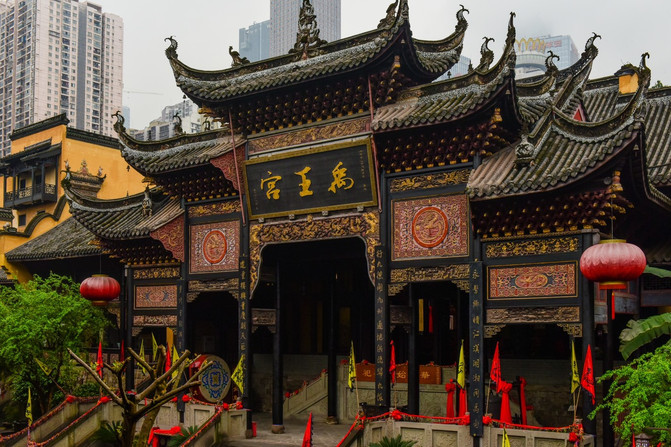


The Chongqing Huguang Fill Sichuan Immigration Museum, located in an antique style new building, is a unique museum that integrates collection, exhibition, protection, research, and experience of immigrant culture. This also vividly depicts an extremely important wave of immigration in the history of human migration - the Huguang Filling Sichuan Immigration Movement

The modern multimedia technology presented indoors allows us to deeply experience the scene of Sichuan immigrants filling Hubei and Guangzhou through the combination of sound, light, and electricity technology.

At that time, unicycles could be used to push goods
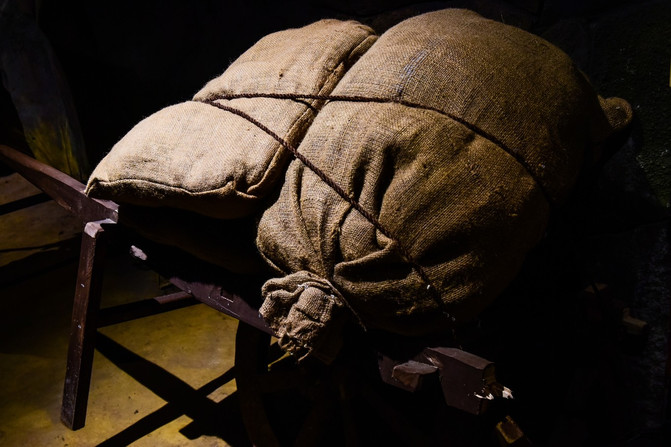
The common people use firewood to make fires and cook rice on their way to immigrate

Medicinal herb shops during that period

A pawnshop that can pawn things

A small shop on the street under the bridge
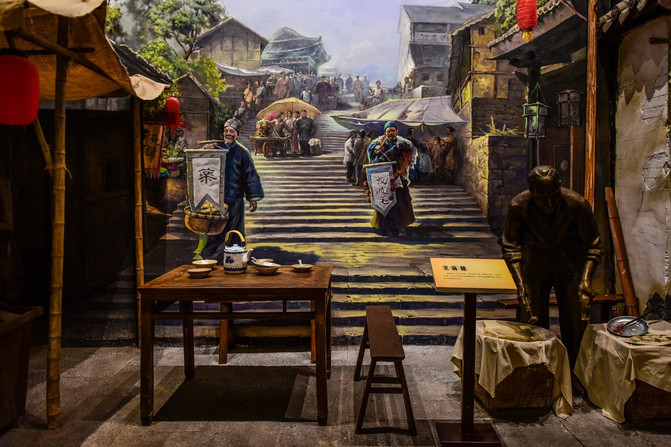
At that time, people used smoking pipes

Young talents participating in the scientific examination system

The antique hall

Being here is like going back to the magnificent immigration movement over 300 years ago.

Everything is vividly remembered

The square water tank under the courtyard is also very interesting, with some beautiful patterns carved on it.

Further up, you will arrive at the Qi'an Public Office and Guangdong Club, where the "theater building" is worth stopping and taking a look at.
The Qi'an Public Office was a place dedicated to VIP performances during that era, and the Guangdong Public Office is the best preserved among the four theater buildings.


Continuing forward, the misty and rainy weather did not affect everyone's interest at all. The flowers they met on the road were kissed by the rain and dew, giving a beautiful feeling.

Passing through the door at this corner and climbing up the stone steps, you will come across the 'Feeling Lazy Tree' inside the museum, which is a cultural exchange space for intangible cultural heritage.

The design in the yard exudes a literary atmosphere, and I particularly like the talking parrot. As we take photos, it keeps shouting 'Baby is angry!' which makes the whole audience burst into laughter. Teacher Yang, the manager of 'Feeling Lazy Tree', also personally told us about the culture of Xiabu.


The raw material for summer cloth is ramie, which is processed into plain weave cloth through traditional manual techniques such as yarn spinning and textile processing. It is called summer cloth. Ramie is widely recognized as the king of natural fibers in the world, historically known as "Fugui Silk". It is a unique resource in China and has the longest cultivation history, dating back over 4700 years.

I was immediately attracted by the grass and trees here, and immediately rolled up my sleeves to personally experience the process of making dyed fabrics with my peers.

Wet the plain fabric in water, then immerse it in plant dyes from light to deep, rinse it with running water, wait for oxidation, and the color of the fabric will change. This process will bring a sense of accomplishment to people.

There are also many Hanfu made of intangible cultural heritage summer cloth indoors, which can be bought home if you like.

Then we arrived at Dongshimen, built in the Ming Dynasty, which is the main entrance to the east of the old city of Chongqing. It is one of the only two ancient city gates in old Chongqing, and in the past, people used to cross the Yangtze River from Yuzhong to the south bank through this gate. During the War of Resistance Against Japan, the city walls had been demolished and people could leave the city everywhere. It was only then that the crossing of the river through Wanglongmen Street gradually became neglected. Nowadays, the Gate City Tower no longer exists.

The Dongshuimen Yangtze River Bridge above the city gate is an important expressway connecting Yuzhong District and Nan'an District, and is a sister bridge to the Qiansimen Bridge Tower


Renhe Street, located by the Jialing River, is connected to Beibei Road, Daxigou, and Renmin Road in the northeast, and Zaozilanya Main Street in the southwest. The entire long street is about 1.26 kilometers long. Because at the beginning of the last century, a wealthy businessman in Chongqing opened an orphanage here, and Nameless Street was initially named "Orphanage Street". Due to the residents living on this street, they often find the street name unpleasant to hear. In 1946, the authorities followed public opinion and renamed Orphanage Street as "Renhe Street", which has been in use ever since.

Many flowers and plants have grown around the city wall, growing together with this period of history.
Baixiang Street is an old street in Chongqing, located between Wanglongmen and Taipingmen. This place has the earliest Western style houses in Chongqing city, combining the characteristics of Chinese and Western cultures. It was once the most luxurious street in Chongqing's architecture, where many influential figures lived and carried half of Chongqing's history.
Nowadays, Baixiang Street has undergone a complete renovation, but its architectural style still retains the style of memories, and it holds an important position in the historical and cultural context of the lower half of Yuzhong city.


We also met a shallow tea house on Baixiang Street, which is the most suitable place to slow down the pace of time and enjoy a cup of spring tea here.

I really like the indoor decoration, fresh and elegant, which can instantly calm even a restless heart.

Clean hands, hairpin flowers, tea tasting, tea conversation Enjoy a ritualistic aesthetic of life.
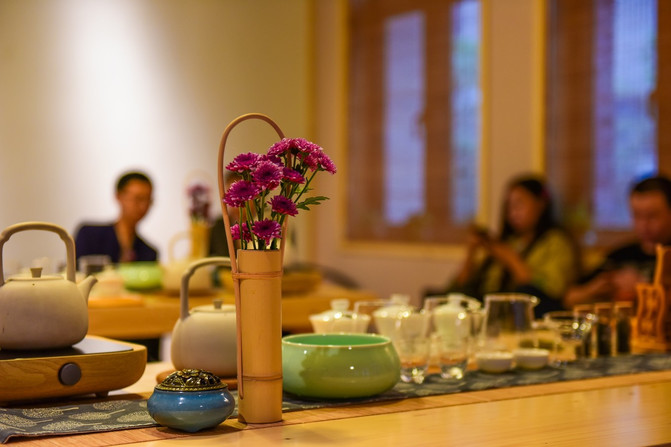
The Tea Fairy, dressed in plain clothes, gently brews tea for everyone. Only by being calm and composed can we brew the best quality and taste of tea.

Passing through the Monument to the people's Liberation Central Cathay Pacific Art Center in Yuzhong District, we came to Luzumiao Old Street, which is the only century old street with the most complete preservation in the core of Chongqing's main city, and also an unrepeatable cultural representative of the old street in the mountain city. You can experience the common culture of Chongqing and feel the warmest human fireworks. This place still maintains the habit of going to the market, where you can stroll around the flower market during the day and become a paradise for delicious food at night.

Eating hot pot has always been the favorite of Chongqing people. This is the local 30 year old restaurant in Chongqing, which is located in the heart of Monument to the people's Liberation.
Address: Floor 2, No. 218, Bayi Road, Monument to the people's Liberation, Yuzhong District, Chongqing, with a per capita price of about 100.

This shop has always adhered to a particular craft and flavor, which is deeply loved by the locals. At night, the foot traffic is overwhelming, so it is recommended to eat earlier to avoid waiting in line for too long.
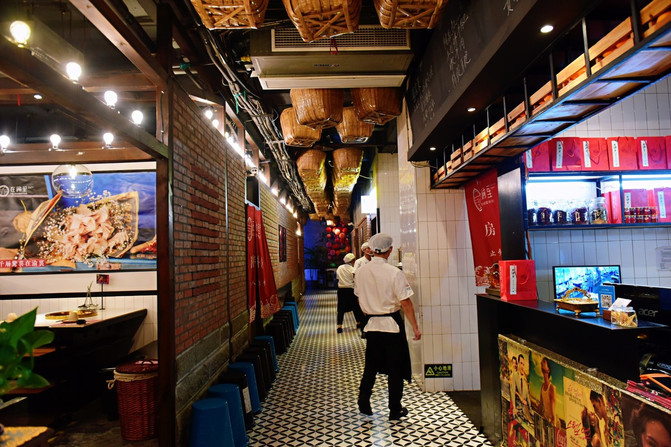
The decoration of hot pot restaurants is a style that young people like, exquisite and atmospheric, with glass chandeliers, retro tables and chairs, suitable for taking photos and checking in.

Their dipping sauce needs to be matched by oneself and there are many choices, but for us locals, it is usually a combination of oil plates and garlic, which is simple and rough. For others, we can add chili, oil consumption, scallions, braised rot, vinegar, sesame paste, etc. according to taste.

The three generation family tradition of spicy butter hotpot uses a very traditional butter pot base. Before eating, you need to open this red bar, which is called& quot; Uncovering ceremony& quot;, The meaning is red and vibrant. As for the taste, the Bashi board is super satisfying, as if the tongue is dancing. Remember to order a pot of old Chongqing handmade sour plum soup when ordering dishes. It's cool and spicy, and the taste is very good.

Once the bottom of the pot boils, you can start blanching the dishes. I can't wait to start cooking!

Let's show off their dishes, each one is super fresh and has a smooth and tender taste.

Featured small county dry is very refreshing and crispy

The crab stick material is also abundant

Premium Beef Roll
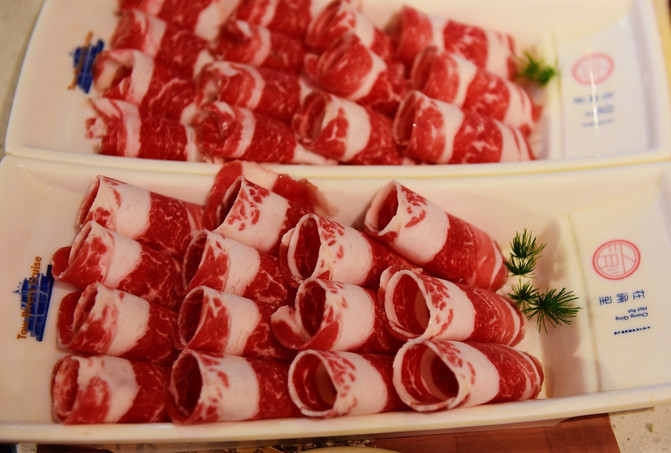
The beef of the Noble Consort has a high appearance, and when opened, a mist rises into the air,

The tripe is also super fresh, packaged in a bouquet, it has a sense of ceremony and feels like it can be given away, haha.

Flammulina velutipes need to be cut in situ

This Rice-meat dumplings is also very powerful
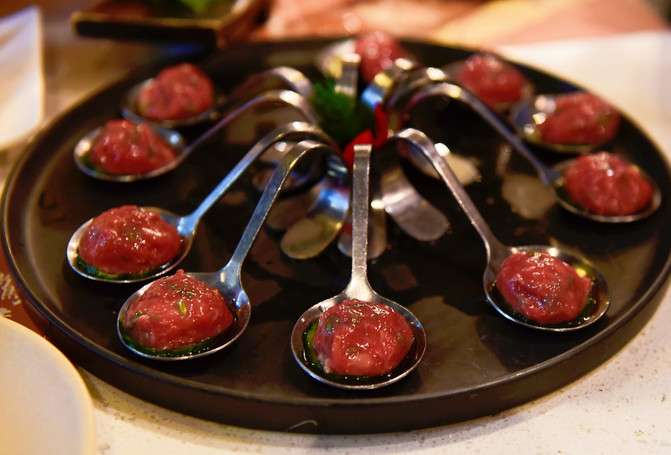
Handmade freshly fried crispy pork must also be served, and can be opened and eaten without scalding.

Handmade fish seeds, fresh shrimp, and smooth noodles are also unbeatable and delicious, with plenty of ingredients.

I also want to praise the Mekong Basha fish. It has no bones and doesn't gain weight after eating. It's not an exaggeration to say that I can eat a plate alone.

Iced fresh duck intestines are a must-have for hot pot, remember not to cook for too long to avoid affecting the crispness.

The meat of the beautiful frog is also pink and tender, freshly peeled. Although it looks a bit cruel, it tastes incredibly delicious.

Finally, another bowl of handmade iced soup garden, perfect!

After dinner, it's the best place to take a walk and eat in the center of Monument to the people's Liberation. There are all kinds of famous brands here. There are a variety of shopping malls and snacks to meet different shopping needs.

May we both love Chongqing and Yuzhong, and go together to understand the 'thickness of life' in our mother city!

Previous Article:Is Chongqing Raffles City just an internet famous building? No, you may have misunderstood. It actually knows Chongqing so well
Next Article:Summer trip to Chongqing in 2019
